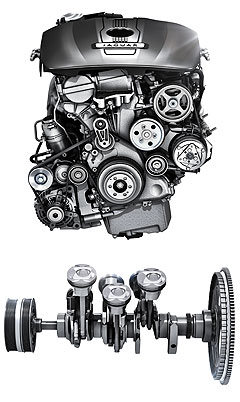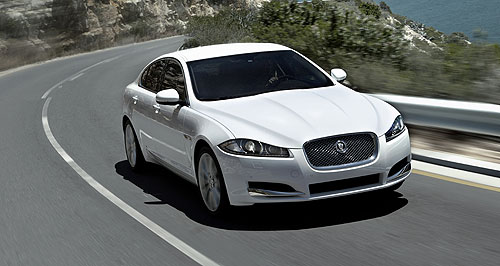Make / Model Search
Future models - Jaguar - XFNew Jaguar engines with benefitsThe Cat’s whiskers: While the four-cylinder variant majors on economy, the new supercharged V6 provides performance to match the 5.0-litre V8 XF and XJ models. Four-cylinder turbo and supercharged V6 petrol engines to join Jaguar fleet25 Apr 2012 By DAVID HASSALL and HAITHAM RAZAGUI JAGUAR Australia will introduce two new petrol engine variants to its growing XF range, including a 2.0-litre turbocharged four-cylinder unit that will provide a luxury car tax break for the BMW 5 Series rival. This would further reduce the entry-level price of the XF range, which only last year came down from $89,900 to $78,900 with the launch of a 2.0-litre turbo-diesel variant. The second engine is a supercharged 3.0-litre V6 that will also find its way into the flagship XJ saloon range and – from mid-late 2013 – the new F-Type sportscar, the first order for which was placed last Friday. Both engines were revealed at the Beijing motor show earlier this week, but will be introduced globally for the 2013 model year. The four-cylinder turbo-petrol is a version of the Ford EcoBoost engine launched in the Ford Falcon this week, and also employed in the Range Rover Evoque. Jaguar Australia brand manager Kevin Goult said the company was keen to get the price of the 2.0-litre XF under the LCT “fuel-efficient car limit” of $75,375 for cars rated at 7.0L/100km or better.  From top: The Jaguar XF's 2.0-litre turbocharged four-cylinder engine. From top: The Jaguar XF's 2.0-litre turbocharged four-cylinder engine.“We have every intention of trying to make that happen,” he told GoAuto. “It is in our customers’ interest. “We recognise where the luxury car tax sits and what we are trying to do is maximise the package for our customer. “This has given us the opportunity to talk to the customer and try to get as close to what might be experienced in Europe as a price. Also, to help us get that way, we are trying to maximise the opportunity of not paying LCT.” Mr Goult said the work to install the EcoBoost engine for rear-drive in Jaguars was independent of Ford Australia’s engineering efforts to fit it into the Falcon. “We have Jaguarised it, with a north-south installation rather than east-west, and set it up properly to be installed in the car that way. “As with the 2.2-litre diesel also used on Land Rover and Range Rover products, we made some changes to reduce NVH and make it a Jaguar-unique fitment. “We have got a dedicated powertrain department and the work would have been done by JLR for JLR. “We don’t partner with Ford for anything. Since the mutual agreement to separate, we have pretty much worked independently and this would have been done by Jaguar engineers. “This is another string to our bow to help us (compete with the Germans). “We are aware there are customers that have a certain price range and this is going to help us operate within that range, so we will see some new customers and non-traditional customers coming to the Jaguar brand.” The turbocharged four-cylinder as fitted to the XF (and the XJ in some global markets) produces 176kW of power at 5500rpm and 340Nm of torque between 1800 and 4000rpm, enabling the XF to accelerate from 0-100km/h in 7.5 seconds – about a second faster than both the 2.2-litre turbo-diesel and the 3.0-litre naturally aspirated V6 petrol. The new 3.0-litre supercharged petrol V6 is said to draw on key technology used in Jaguar’s acclaimed 5.0-litre V8, including direct injection, variable valve timing and aluminium construction. Despite producing less power than the V8 (250kW versus 283kW) and less torque as well (450Nm versus 515Nm), it provides superior acceleration due to its lower weight, powering both the XF and XJ from 0-100km/h in 5.7 seconds, the same as the V8-powered models. An even more powerful version of the 3.0 V6 S/C has been produced for exclusive use in the long-awaited F-Type sportscar, providing a performance boost of 30kW and 10Nm. Both engines will be linked to Jaguar’s existing eight-speed automatic transmission, with the V6 also getting an idle-stop function. Jaguar also employs supercharging on the 5.0-litre V8, which produces 375kW/625Nm in lesser models and 404kW/680Nm in the company’s range-topping $340,000 XKR-S. Jaguar Cars global brand director Adrian Hallmark said the new engines added to what he described as the company’s strongest range of products for several decades. “Our continued growth is dependent on two things activating the awareness of the brand, and expanding our range to enable us to access new customers in both existing and emerging markets,” he said. “The introduction of these two additional forced-induction petrol engines is integral to this ambitious plan.”  Read more27th of January 2012  Jaguar 2011 XF 2.2D Premium Luxury sedanFacelift and new four-cylinder diesel makes Jaguar's XF a serious contenderAll future models Alfa Romeo Alfa Romeo Abarth Abarth Alpine Alpine Alpina Alpina Audi Audi Aston Martin Aston Martin BMW BMW Bentley Bentley Chery Chery Brabham Brabham Chrysler Chrysler Chevrolet Chevrolet Cupra Cupra Citroen Citroen DS DS Dodge Dodge Fiat Fiat Ferrari Ferrari Foton Foton Ford Ford Great Wall Great Wall FPV FPV Haval Haval GWM GWM Honda Honda Holden Holden Hummer Hummer HSV HSV Infiniti Infiniti Hyundai Hyundai Jaguar Jaguar Isuzu Isuzu Kia Kia Jeep Jeep Land Rover Land Rover Lamborghini Lamborghini Lexus Lexus LDV LDV Mahindra Mahindra Lotus Lotus Mazda Mazda Maserati Maserati Mercedes-AMG Mercedes-AMG McLaren McLaren MG MG Mercedes-Benz Mercedes-Benz Mitsubishi Mitsubishi Mini Mini Opel Opel Nissan Nissan Peugeot Peugeot Pagani Pagani Proton Proton Porsche Porsche Renault Renault Ram Ram Rover Rover Rolls-Royce Rolls-Royce Skoda Skoda Saab Saab SsangYong SsangYong Smart Smart Suzuki Suzuki Subaru Subaru Toyota Toyota Tesla Tesla Volvo VolvoXF pricing
Motor industry news |
Click to shareJaguar modelsResearch Jaguar All future models Alfa Romeo Alfa Romeo Abarth Abarth Alpine Alpine Alpina Alpina Audi Audi Aston Martin Aston Martin BMW BMW Bentley Bentley Chery Chery Brabham Brabham Chrysler Chrysler Chevrolet Chevrolet Cupra Cupra Citroen Citroen DS DS Dodge Dodge Fiat Fiat Ferrari Ferrari Foton Foton Ford Ford Great Wall Great Wall FPV FPV Haval Haval GWM GWM Honda Honda Holden Holden Hummer Hummer HSV HSV Infiniti Infiniti Hyundai Hyundai Jaguar Jaguar Isuzu Isuzu Kia Kia Jeep Jeep Land Rover Land Rover Lamborghini Lamborghini Lexus Lexus LDV LDV Mahindra Mahindra Lotus Lotus Mazda Mazda Maserati Maserati Mercedes-AMG Mercedes-AMG McLaren McLaren MG MG Mercedes-Benz Mercedes-Benz Mitsubishi Mitsubishi Mini Mini Opel Opel Nissan Nissan Peugeot Peugeot Pagani Pagani Proton Proton Porsche Porsche Renault Renault Ram Ram Rover Rover Rolls-Royce Rolls-Royce Skoda Skoda Saab Saab SsangYong SsangYong Smart Smart Suzuki Suzuki Subaru Subaru Toyota Toyota Tesla Tesla Volvo VolvoXF pricing
Motor industry news |











Facebook Twitter Instagram